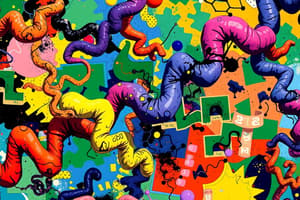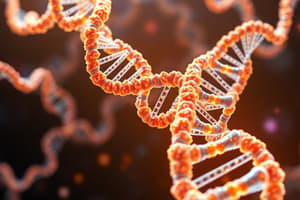Podcast
Questions and Answers
What is the primary structure of proteins?
What is the primary structure of proteins?
- The order in which amino acids are covalently linked (correct)
- The ordered 3-D arrangement of backbone atoms
- The 3-D arrangement of all atoms in a protein
- The arrangement of subunits within a protein
Which level of protein structure involves the 3-D arrangement of all atoms, including those in prosthetic groups?
Which level of protein structure involves the 3-D arrangement of all atoms, including those in prosthetic groups?
- Secondary structure
- Quaternary structure
- Primary structure
- Tertiary structure (correct)
What effect can a single change in the amino acid sequence have on a protein?
What effect can a single change in the amino acid sequence have on a protein?
- It will not affect the protein at all
- It can enhance the protein's stability
- It can change the protein's synthesis rate
- It can alter the protein's biological functions (correct)
What are the native conformations of proteins?
What are the native conformations of proteins?
Which statement best describes tertiary protein structure?
Which statement best describes tertiary protein structure?
What is characterized by the arrangement of subunits in a protein?
What is characterized by the arrangement of subunits in a protein?
Why can proteins have many different conformations?
Why can proteins have many different conformations?
Which type of structure is primarily concerned with the ordered 3-D arrangement of the protein backbone atoms?
Which type of structure is primarily concerned with the ordered 3-D arrangement of the protein backbone atoms?
What stabilizes the α-helical regions in myoglobin (Mb)?
What stabilizes the α-helical regions in myoglobin (Mb)?
Which type of secondary structure is absent in myoglobin?
Which type of secondary structure is absent in myoglobin?
Where are most polar side chains located in the structure of myoglobin?
Where are most polar side chains located in the structure of myoglobin?
Which component is involved in interactions with the heme group in myoglobin?
Which component is involved in interactions with the heme group in myoglobin?
What occupies the fifth coordination site of the Fe(II) in the heme group?
What occupies the fifth coordination site of the Fe(II) in the heme group?
What is the composition of the porphyrin ring in the heme group?
What is the composition of the porphyrin ring in the heme group?
How many coordination sites does the heme group possess for the Fe(II)?
How many coordination sites does the heme group possess for the Fe(II)?
What binds at the sixth coordination site of the heme group?
What binds at the sixth coordination site of the heme group?
What is a βαβ unit comprised of?
What is a βαβ unit comprised of?
Which supersecondary structure is also known as a helix-turn-helix?
Which supersecondary structure is also known as a helix-turn-helix?
What characterizes the β-meander supersecondary structure?
What characterizes the β-meander supersecondary structure?
Which of the following is true about motifs in protein structure?
Which of the following is true about motifs in protein structure?
How can a domain be defined?
How can a domain be defined?
What does it mean when it is said that domains are units of function?
What does it mean when it is said that domains are units of function?
What is the distinguishing feature of a β-barrel structure?
What is the distinguishing feature of a β-barrel structure?
Which statement correctly describes the Greek key motif?
Which statement correctly describes the Greek key motif?
What is the role of histidine F8 in relation to the iron in heme?
What is the role of histidine F8 in relation to the iron in heme?
Which type of protein structure does hemoglobin represent?
Which type of protein structure does hemoglobin represent?
How does carbon monoxide (CO) compare to oxygen (O2) in terms of affinity for free heme?
How does carbon monoxide (CO) compare to oxygen (O2) in terms of affinity for free heme?
What structural characteristic defines oligomers?
What structural characteristic defines oligomers?
What property describes allosteric behavior in multisubunit proteins?
What property describes allosteric behavior in multisubunit proteins?
Which statement accurately describes hemoglobin's structure?
Which statement accurately describes hemoglobin's structure?
What happens to carbon monoxide's advantage over oxygen when it binds at an angle?
What happens to carbon monoxide's advantage over oxygen when it binds at an angle?
Which of the following is NOT a method of interaction between polypeptide chains in quaternary structures?
Which of the following is NOT a method of interaction between polypeptide chains in quaternary structures?
What defines the tertiary structure of proteins?
What defines the tertiary structure of proteins?
Which interaction is NOT involved in stabilizing the tertiary structure of proteins?
Which interaction is NOT involved in stabilizing the tertiary structure of proteins?
What role do prosthetic groups play in the structure of myoglobin?
What role do prosthetic groups play in the structure of myoglobin?
In which type of protein is the backbone less likely to fold back on itself?
In which type of protein is the backbone less likely to fold back on itself?
What can restrict the folding patterns of polypeptide chains in proteins?
What can restrict the folding patterns of polypeptide chains in proteins?
How do the side chains of amino acids influence the tertiary structure of proteins?
How do the side chains of amino acids influence the tertiary structure of proteins?
What type of structure do helical and pleated-sheet sections create in proteins?
What type of structure do helical and pleated-sheet sections create in proteins?
Which of the following proteins contains disulfide bonds?
Which of the following proteins contains disulfide bonds?
Flashcards are hidden until you start studying
Study Notes
Overview of Protein Structure
- Proteins are polymers formed by amino acids linked by covalent peptide bonds.
- Native conformations are the specific 3-D shapes that enable biological activity.
- Proteins can have segments of random structure without obvious repeating patterns.
Levels of Protein Structure
- Primary Structure (1°): The linear sequence of amino acids, read from N-terminal to C-terminal.
- Secondary Structure (2°): The ordered 3-D arrangement of the polypeptide backbone, typically involving α-helices and β-sheets.
- Tertiary Structure (3°): The overall 3-D arrangement of all atoms, accounting for side chains and any prosthetic groups.
- Quaternary Structure (4°): The arrangement of multiple polypeptide subunits in relation to each other, forming larger functional complexes.
Primary Structure Insights
- Amino acid sequences dictate protein conformation and function; single amino acid changes can significantly impact biological activity (e.g., sickle-cell anemia due to Glu6 → Val substitution in hemoglobin).
- Supersecondary structures result from combinations of α- and β-strands.
- βαβ Unit: Two parallel β-strands connected by an α-helix.
- αα Unit: Two antiparallel α-helices, also known as a helix-turn-helix motif.
- β-Meander: Antiparallel β-sheets linked by tight reverse turns.
- Greek Key: A structural motif formed by a polypeptide chain looping back on itself.
- Motifs offer insights into protein folding but do not predict function.
- Domains are independently folding segments of polypeptides and units of function.
Tertiary Structure Details
- Tertiary structure incorporates all atoms, including side chains and prosthetic groups.
- Fibrous proteins have elongated, rod-like shapes, while globular proteins have more compact structures.
- Forces Stabilizing Tertiary Structure:
- Noncovalent interactions (hydrogen bonds, hydrophobic interactions, electrostatic attractions).
- Disulfide bonds restrict folding patterns, varying between proteins (present in chymotrypsin but absent in myoglobin).
Myoglobin Structure
- Myoglobin is composed of a single polypeptide with 153 amino acids and a heme prosthetic group within a hydrophobic pocket.
- Exhibits eight α-helical regions and no β-pleated sheets.
- Polar side chains reside on the exterior, while the interior contains mostly nonpolar side chains and polar histidines that interact with the heme group.
- The heme group binds oxygen, with its conformation significantly influenced by the protein environment.
Heme Group Characteristics
- Contains Fe(II) linked to an organic protoporphyrin IX structure, facilitating oxygen binding at the sixth coordination site.
- Four coordination sites occupied by nitrogen atoms, with the fifth occupied by the imidazole side chain of histidine residue F8.
- Oxygen has a weaker affinity than carbon monoxide; CO is a potent poison due to its high binding affinity.
Quaternary Structure Features
- Comprises proteins with multiple polypeptide chains, referred to as subunits.
- Oligomers include proteins like dimers, trimers, and tetramers, which interact primarily through noncovalent forces.
- Allosteric properties allow conformational changes in one subunit to influence neighboring subunits, critical for functional regulation.
Hemoglobin Structure
- Hemoglobin is a tetramer (α2β2), containing two α-chains and two β-chains.
- Each chain has distinct lengths (141 residues for α and 146 for β).
- Amino acid sequences of hemoglobin chains are homologous to myoglobin, illustrating evolutionary relationships among hemoproteins.
Studying That Suits You
Use AI to generate personalized quizzes and flashcards to suit your learning preferences.




